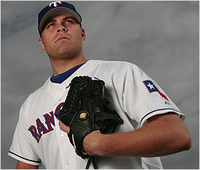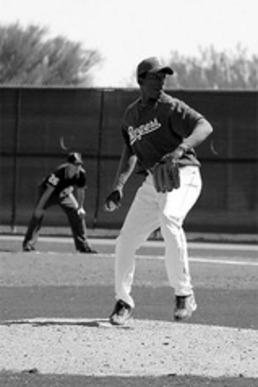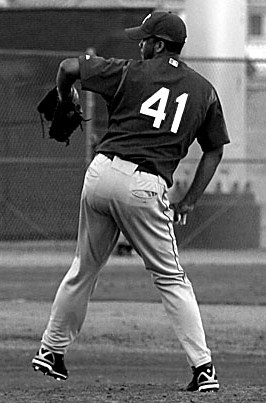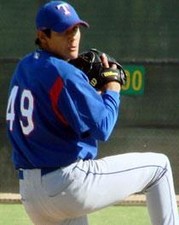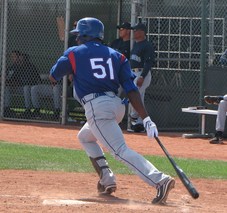Here are the top 40 starting pitchers in Major League Baseball, by ERA, and how their current club acquired them, with 2008 salary. Kazmir lacks the innings to qualify, but I added him in anyway.
And just to make you feel bad, former Rangers property are in bold type:
Player Club ERA How Acquired Salary
1) Justin Duchscherer OAK 2.02 Minor League Trade $2,000,000
** Scott Kazmir TB 2.03 Pre-Arb Trade $3,700,000
2) Edinson Volquez CIN 2.08 Pre-Arb Trade $380,000
3) Cliff Lee CLE 2.34 Minor League Trade $4,000,000
4) Tim Lincecum SF 2.54 Draft $380,000
5) Ben Sheets MIL 2.59 Draft (Re-Signed) $12,000,000
6) John Danks CWS 2.62 Minor League Trade $380,000
7) Ryan Dempster CHC 2.63 Free Agent $7,000,000
8) Shaun Marcum TOR 2.65 Draft $380,000
9) Felix Hernandez SEA 2.83 Int’l Free Agent $540,000
10) Johan Santana NYM 2.93 Pre-FA Trade $17,000,000
11) Tim Hudson ATL 2.96 Pre-FA Trade $15,000,000
12) Joe Saunders LAA 3.03 Draft $400,000
13) Dan Haren AZ 3.04 Pre-FA Trade $4,000,000
14) Roy Halladay TOR 3.12 Draft (Re-Signed) $10,000,000
15) Jon Lester BOS 3.13 Draft $380,000
16) Carlos Zambrano CHC 3.13 Int’l FA (Re-Signed) $16,000,000
17) Adam Wainwright STL 3.14 Minor League Trade $687,000
18) Jair Jurrjens ATL 3.20 Minor League Trade $380,000
19) Brandon Webb AZ 3.23 Draft $5,500,000
20) Cole Hamels PHI 3.27 Draft $500,000
21) Ervin Santana LAA 3.32 Int’l FA $420,000
22) Armando Galarraga DET 3.32 Minor League Trade $380,000
23) John Lannan WAS 3.34 Draft $380,000
24) Gavin Floyd CWS 3.39 Minor League Trade $380,000
25) Zack Greinke KC 3.40 Draft $1,400,000
26) Scott Olsen FLA 3.44 Draft $400,000
27) Todd Wellemeyer STL 3.46 Draft $1,000,000
28) Dana Eveland OAK 3.51 Minor League Trade $380,000
29) Greg Maddux SD 3.52 Free Agent $10,000,000
30) Aaron Cook COL 3.64 Draft $5,000,000
31) Chad Billingsley LAD 3.64 Draft $400,000
32) Jeremy Guthrie BAL 3.64 Minor League Trade $770,000
33) Nick Blackburn MIN 3.68 Undrafted $380,000
34) Greg Smith OAK 3.69 Minor League Trade $380,000
35) Josh Beckett BOS 3.73 Pre-FA Trade $10,000,000
36) John Maine NYM 3.73 Minor League Trade $450,000
37) Vicente Padilla TEX 3.74 Pre-FA Trade (Re-Signed) $11,000,000
39) Jamie Shields TB 3.76 Draft $1,000,000
40) Matt Garza TB 3.76 Minor League Trade $380,000
OK: So what’s Mike’s point here?
Don’t let anyone tell you that spending money on starting pitchers in free agency is the way to go. There is simply NO EVIDENCE to support that argument.
It’s all about scouting and development folks.
Out of the top 41 (including Kazmir), here’s how teams acquired these pitchers:
Draft (or undrafted American signee): 16
Free Agent Signee: 2
International (Teen) Free Agent Signee: 3
Minor League Trade: 12
Pre-Free Agency Trade: 8
You either draft and grow it (Kazmir, Lincecum, Sheets, Marcum, Saunders, Lester, Webb, Hamels…)….
Or you use superior scouting to get your hands on someone else’s young arms when it comes time to sell (Duchscherer, Danks, Volquez, Lee, Floyd, Wainwright, Eveland, Smith…)….
Or you use your stocked farm system to trade for the stud before he becomes a Free Agent (Beckett, Hudson, Johan, Haren…)….
Or you find the stud when he’s 16 years old in the Dominican Republic or Venezuela (Felix, Zambrano, Santana…)….
But you do NOT go out and buy it on the open market.
It just doesn’t work that way.
